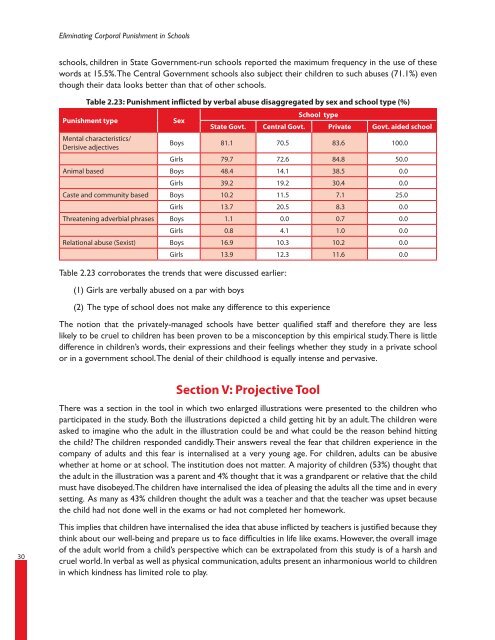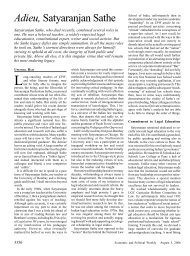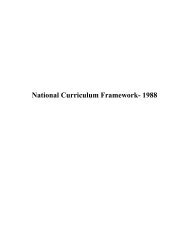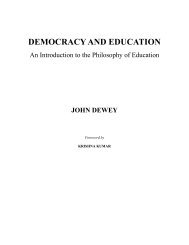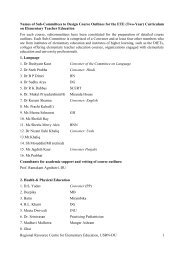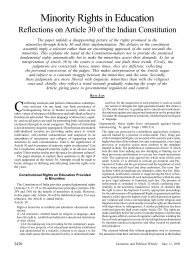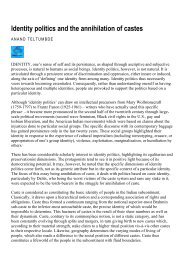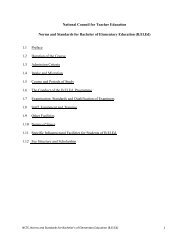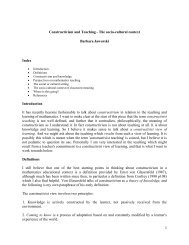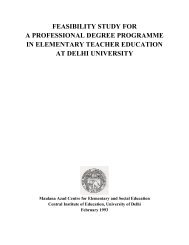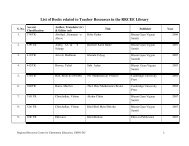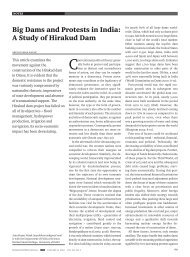Corporal Punishment - Eledu.net
Corporal Punishment - Eledu.net
Corporal Punishment - Eledu.net
Create successful ePaper yourself
Turn your PDF publications into a flip-book with our unique Google optimized e-Paper software.
Eliminating <strong>Corporal</strong> <strong>Punishment</strong> in Schoolsschools, children in State Government-run schools reported the maximum frequency in the use of thesewords at 15.5%. The Central Government schools also subject their children to such abuses (71.1%) eventhough their data looks better than that of other schools.Table 2.23: <strong>Punishment</strong> inflicted by verbal abuse disaggregated by sex and school type (%)<strong>Punishment</strong> typeSexSchool typeState Govt. Central Govt. Private Govt. aided schoolMental characteristics/Derisive adjectivesBoys 81.1 70.5 83.6 100.0Girls 79.7 72.6 84.8 50.0Animal based Boys 48.4 14.1 38.5 0.0Girls 39.2 19.2 30.4 0.0Caste and community based Boys 10.2 11.5 7.1 25.0Girls 13.7 20.5 8.3 0.0Threatening adverbial phrases Boys 1.1 0.0 0.7 0.0Girls 0.8 4.1 1.0 0.0Relational abuse (Sexist) Boys 16.9 10.3 10.2 0.0Girls 13.9 12.3 11.6 0.0Table 2.23 corroborates the trends that were discussed earlier:(1) Girls are verbally abused on a par with boys(2) The type of school does not make any difference to this experienceThe notion that the privately-managed schools have better qualified staff and therefore they are lesslikely to be cruel to children has been proven to be a misconception by this empirical study. There is littledifference in children’s words, their expressions and their feelings whether they study in a private schoolor in a government school. The denial of their childhood is equally intense and pervasive.Section V: Projective ToolThere was a section in the tool in which two enlarged illustrations were presented to the children whoparticipated in the study. Both the illustrations depicted a child getting hit by an adult. The children wereasked to imagine who the adult in the illustration could be and what could be the reason behind hittingthe child? The children responded candidly. Their answers reveal the fear that children experience in thecompany of adults and this fear is internalised at a very young age. For children, adults can be abusivewhether at home or at school. The institution does not matter. A majority of children (53%) thought thatthe adult in the illustration was a parent and 4% thought that it was a grandparent or relative that the childmust have disobeyed. The children have internalised the idea of pleasing the adults all the time and in everysetting. As many as 43% children thought the adult was a teacher and that the teacher was upset becausethe child had not done well in the exams or had not completed her homework.30This implies that children have internalised the idea that abuse inflicted by teachers is justified because theythink about our well-being and prepare us to face difficulties in life like exams. However, the overall imageof the adult world from a child’s perspective which can be extrapolated from this study is of a harsh andcruel world. In verbal as well as physical communication, adults present an inharmonious world to childrenin which kindness has limited role to play.


